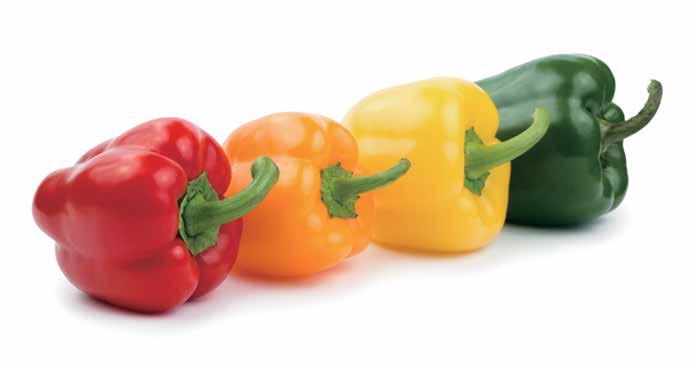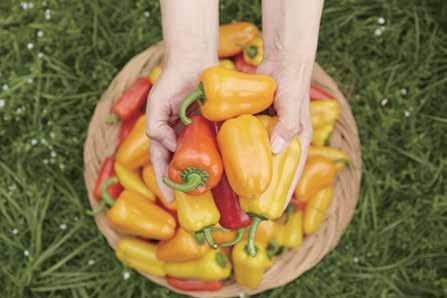
4 minute read
Paprika: a jewel among vegetables that is filled with nutrition
from April 2018 (vol.270)
by AgroTrade aT
Korean paprika peppers are the third most exported fresh produce item in Korea. In 2016, Korea exported 89 million dollar worth of paprika; in January of this year, exports were up by 23.8% compared to the same period in the previous year. And not only are Korean paprika peppers varied in color and rich in nutrition, they are high in quality, as they are cultivated systematically in a clean environment.
A cultivated form of bell peppers, paprika peppers are rich in water, and have a thick skin and a very sweet flavor. There are more than 10 different colors of paprika, including red and orange. They are rich in nutrients such as vitamins and iron. 100g of Paprika holds 375mg of Vitamin C, which is 1.5 times the amount in strawberries and 5 times the amount in spinach. They are also rich in Vitamin A, and since this vitamin withstands heat very well it is good to eat Paprika after stir frying it. They also help in preventing colds, and include a great deal of antioxidants.
Advertisement
For these reasons, paprika peppers are popular both in Korea and overseas. Paprika exports are organized systematically through the Organization of Paprika Export Associations (KOPA). The export competitiveness of domestic paprika peppers has been increased through careful cultivation, harvesting, sorting, packing, exporting, safety and quality control, and farming education. Ninety percent of Korean paprika peppers are exported to the Japanese market, for which they must undergo a strict screening. Korean paprika peppers are also being exported to an increasing number of other Asian countries.

Colorful efficacy
Paprika peppers have a slightly different nutritional value depending on their color. Green paprika peppers have fewer calories than other paprika peppers, making them good for losing weight. They are rich in organic matter and iron, which helps prevent anemia. Because they are harvested before the pepper is ripe, they are not very sweet. Orange paprika peppers contain large amounts of provitamin A, which controls cholesterol. They also relieve eye fatigue and contain an abundant supply of vitamins and minerals such as calcium, potassium and iron. Yellow paprika peppers are not spicy, but are very sweet. They contain a great deal of Vitamin C and lutein pigment, a kind of carotenoid, which is effective for eye health. Red paprika peppers contain a lot of lycopene. Lycopene has strong antioxidant, anti-aging, and cancer prevention effects. They are also rich in calcium and phosphorus, making them good for children.
Laon: big, crispy, and domestically produced mini paprika

Paprika seeds are priced at about 500-600 won per pound, 10 times the price of pepper; this is 1200- 1500 won for mini paprika. As well, the domestically produced paprika peppers that have been cultivated until now produced about half the yield of a regular paprika. The cultivated form of mini paprika is the domestically produced Laon paprika. The Laon paprika pepper has a large size of about 55g. Its skin is thick, and its texture is crisp. They are cultivated mainly in Gyeongsangnam-do area, and can replace about 70 percent of domestic supply of cultivated mini paprika peppers.
Laon paprikas are popular in the Japanese market
In 2016, 50 tons of Laon paprika peppers, produced in Hapcheon, Gyeongsangnam-do, and Jinju, were exported to Japan. Laon paprika peppers are popular among Japanese consumers, and are considered a promising new export item. As well, exports of Korean mini paprika are increasing. In March of this year, Laon paprika peppers were exported to Mexico for the first time.
Major cultivation areas in Korea
Highlands in Gangwon-do: a great place for cultivating paprika peppers in the summer

The paprika peppers produced in the highlands of Gangwon-do, which are more than 600 meters above sea level, are very popular in overseas markets because of their excellent quality and storability. Highland farmers are doing their utmost to preserve quality through natural pest control, safety education, and inspection of pesticide safety use. Safety has also been improved, in order to receive the Good Agricultural Practices (GAP) certification.
Gimje, Jeollabuk-do: the area that opened the door for paprika peppers

Exports of Korean paprika peppers to Japan began in Gimje, Jeollabuk-do. Here, peppers are grown in greenhouses and maintain their high quality throughout the year, which has enhanced the reputation of Korean paprika. Paprika drinks and other processed foods are also being developed to increase the domestic consumption of paprika peppers.
Hapcheon and Jinju, Gyeongsangnam-do: precise management at cutting-edge facilities

The cultivation area in Gyeongsangnam-do is optimized for exports to Japan; its proximity to Japan makes it easier to preserve the freshness of the paprika peppers. Also, the peppers are managed with ‘smart farm’ technology in an advanced glass greenhouse, enabling the production of high quality peppers. Significantly, 9.7 million dollar worth of paprika peppers produced in Jinju was exported last year, a record export performance.

